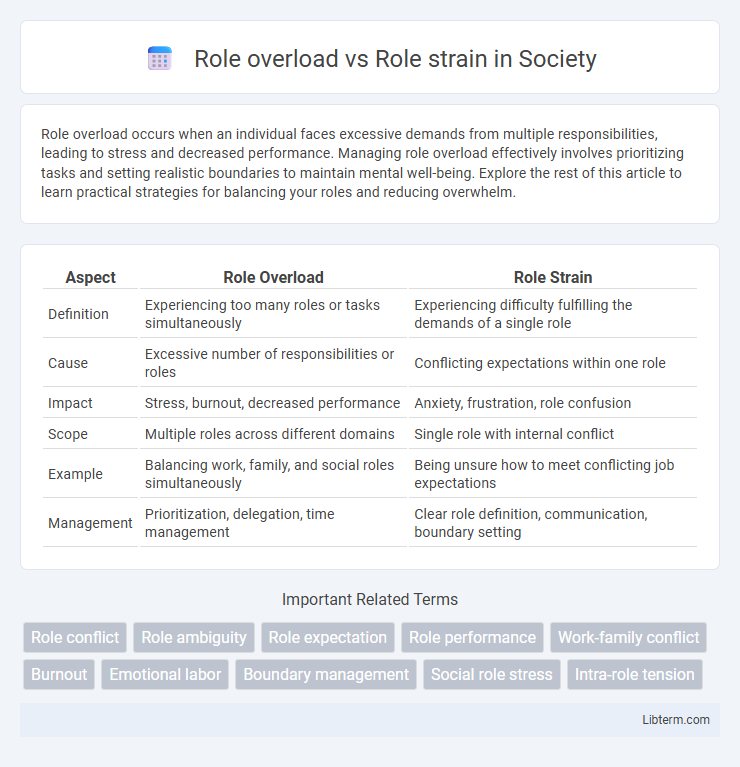Role overload occurs when an individual faces excessive demands from multiple responsibilities, leading to stress and decreased performance. Managing role overload effectively involves prioritizing tasks and setting realistic boundaries to maintain mental well-being. Explore the rest of this article to learn practical strategies for balancing your roles and reducing overwhelm.
Table of Comparison
| Aspect | Role Overload | Role Strain |
|---|---|---|
| Definition | Experiencing too many roles or tasks simultaneously | Experiencing difficulty fulfilling the demands of a single role |
| Cause | Excessive number of responsibilities or roles | Conflicting expectations within one role |
| Impact | Stress, burnout, decreased performance | Anxiety, frustration, role confusion |
| Scope | Multiple roles across different domains | Single role with internal conflict |
| Example | Balancing work, family, and social roles simultaneously | Being unsure how to meet conflicting job expectations |
| Management | Prioritization, delegation, time management | Clear role definition, communication, boundary setting |
Understanding Role Overload
Role overload occurs when an individual faces excessive demands across multiple roles, leading to heightened stress and decreased performance. It differs from role strain, which primarily involves difficulties within a single role due to conflicting expectations or pressures. Understanding role overload is crucial for managing stress and improving time allocation in environments such as workplaces or caregiving situations.
Defining Role Strain
Role strain occurs when an individual faces difficulty fulfilling the expectations of a single role due to conflicting demands or limited resources within that role. Unlike role overload, which involves having too many roles or tasks, role strain emphasizes the internal challenges and stress related to managing responsibilities inherent to one specific role. This concept is crucial for understanding stress factors in roles such as parenting, caregiving, or professional positions where competing role requirements can impact performance and well-being.
Key Differences Between Role Overload and Role Strain
Role overload occurs when an individual faces excessive demands from multiple roles, leading to time constraints and physical exhaustion, whereas role strain refers to the stress experienced within a single role due to conflicting expectations or insufficient resources. Role overload emphasizes the quantity of responsibilities, while role strain highlights the quality and compatibility of role demands. Understanding these distinctions aids in targeted interventions to improve role management and reduce psychological stress.
Causes of Role Overload in Modern Life
Role overload in modern life primarily stems from the increasing demands of multiple roles, including professional responsibilities, family obligations, and social engagements, often leading to insufficient time and energy to fulfill all tasks effectively. Technological advancements, while enhancing connectivity and efficiency, contribute to blurred boundaries between work and personal life, intensifying expectations and constant availability. Furthermore, societal pressures for multitasking and high achievement exacerbate role overload, causing significant stress and decreased well-being.
Common Sources of Role Strain
Common sources of role strain include conflicting demands within a single role, unclear expectations, and lack of necessary resources or support. Role strain often arises from high responsibility levels, time pressure, and emotional labor required by the role. Unlike role overload, which involves excessive roles or tasks, role strain is centered on difficulties managing the pressures inherent in a single role.
Psychological Impacts of Role Overload
Role overload occurs when individuals face excessive demands from multiple roles, leading to heightened stress, anxiety, and burnout. This psychological burden reduces coping capacity, impairs cognitive function, and can trigger depressive symptoms. The persistent pressure of role overload disrupts work-life balance, resulting in decreased job satisfaction and impaired overall mental health.
Emotional Consequences of Role Strain
Role strain occurs when an individual faces conflicting demands within a single role, leading to emotional consequences such as stress, anxiety, and feelings of inadequacy. Unlike role overload, which involves too many roles or tasks, role strain specifically triggers emotional exhaustion due to internal role conflict and unmet role expectations. Persistent role strain can result in reduced psychological well-being and increased risk of depression.
Strategies to Manage Role Overload
Role overload occurs when the demands of multiple roles exceed an individual's capacity, leading to stress and decreased performance. Effective strategies to manage role overload include prioritizing tasks, delegating responsibilities, and setting realistic goals to balance workload. Time management techniques and seeking social support also help mitigate the pressure associated with excessive role demands.
Coping Mechanisms for Role Strain
Role strain occurs when conflicting demands within a single role create stress, often leading to emotional exhaustion and reduced performance. Effective coping mechanisms for role strain include time management strategies, seeking social support, and cognitive reframing to adjust perceptions of role expectations. Mindfulness practices and setting realistic boundaries help individuals maintain emotional balance and prevent burnout while fulfilling role responsibilities.
The Importance of Balancing Multiple Roles
Balancing multiple roles effectively prevents role overload, which occurs when the demands of various responsibilities exceed an individual's capacity. Role strain emerges from the stress and tension experienced when conflicting expectations arise within a single role or between multiple roles. Prioritizing time management and clear boundaries enhances well-being and productivity by mitigating the negative effects of both role overload and role strain.
Role overload Infographic

 libterm.com
libterm.com